

BUTTERFLIES, MOTHS AND SKIPPERS (LEPIDOPTERA) OF BRITISH COLUMBIA
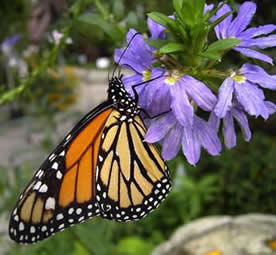
Monarch Butterfly (Danaus plexippus), photo by Diane Williamson
by
R. A. Cannings and G. G. E. Scudder
Copyright © 2007 - All rights reserved
Extracted from the forthcoming publication The Insect Families of British Columbia.
Click here to view read about the Lepidoptera families of British Columbia.
Click here for the 2008 list of the Lepidoptera species of British Columbia.
Click here to view a PDF of the Lepidoptera of Alberta.
In British Columbia, there are about 2285 species of Lepidoptera recorded -- 184 are butterflies (including 29 skippers) and 2101 are moths. These numbers vary depending on the authorities consulted. While there is public recognition of two distinct and separate groups, "moths" and "butterflies", experts include butterflies and the closely related skippers within the much larger assemblages of moths. All these are then classified in the single insect order Lepidoptera. The introduction below provides an insight into this group based on the experience of the authors.
Introduction (draft only)
Globally, about 150,000 species of living Lepidoptera have been described in approximately 124 families. At the species level, this is about 17 % of the world’s known insect fauna. However, estimates suggest that there may be two or three times this number of species in the order. The Lepidoptera is the largest lineage of plant eating organisms, rivalled only by the huge clade of phytophagous (plant eating) beetles(Coleoptera) that includes the weevils, leaf beetles and longhorned beetles, a group of at least 125,000 named species. Angiosperm plants are the main hosts. The fossil record is sparse and is best represented by amber inclusions and leaf mines in fossil leaves. Although the first known moth fossils are from the early Jurassic, 190 million years ago, the order largely diversified in the Cretaceous Period and early Tertiary with the flowering plants. Thus, of all the orders of insects, the Lepidoptera have radiated most recently.
Lepidopterous larvae are commonly called caterpillars. Usually cylindrical, they have a well-developed head, thorax (the top of the prothorax is usually sclerotized) and a 10-segmented abdomen. There are three pairs of 5-segmented thoracic legs and usually five pairs of abdominal prolegs (segments 3 to 6 and 10). Prolegs are short and fleshy; the tips usually have tiny hooks (crochets). In some groups the thoracic legs and/or prolegs may be reduced or lost Larvae lack compound eyes but there are usually six ocelli on each side of the head. Larvae mainly feed with chewing mandibles, although these are modified in some sap-feeding, leaf-mining forms. Many larvae are hairy or spiny in characteristic ways; sometimes these projections are stinging. Silk is spun from modified salivary glands that open under the mouth; the silk is used mainly to make cocoons or other shelters. Many larvae pupate in cocoons; others make none. Moth pupae are usually smooth and brown. Butterflies usually do not make a cocoon and the naked pupa is often called a chrysalis – it can be sculptured or brightly coloured and frequently is fastened to a plant with a silken girdle.
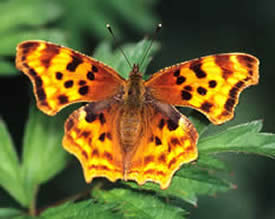
Satyr Anglewing (Polygonia satyrus), photo by Ian Lane
Click here to view a list of the Lepidoptera familes of BC
How to recognize a butterfly or moth
Contrary to the popular belief that butterflies and moths are two separate groups that comprise the Lepidoptera, butterflies are simply relatively recently derived, colourful, day-flying moths in the Macrolepidoptera consisting of the superfamilies Hesperioidea and Papilionoidea. The most closely related moths are in the small neotropical family Hedylidae (about 40 species in the genus Macrosoma), which many authorities consider to be butterflies because they share some ancestral butterfly characters, including a girdled pupa, upright eggs and a pouch on abdominal segment 1.
Members of the Lepidoptera are distinguished in the adult stage by the dense covering of overlapping scales on the head, body and appendages, including the two pairs of membranous wings. Wingspans range from about 3 mm to 280 mm. A few species have reduced, non-functional wings; these are usually females, but in some species both sexes are flightless. The scales are coloured and arranged in innumerable patterns, from the subtle and cryptic to the bright and showy.
The compound eyes are large, often with hairs between the facets; ocelli are absent (in butterflies and many moths) or are present, one above each eye. Antennae are long and slender, usually partly clothed with scales and composed of two basal segments and a flagellum of 20 to 60 units. The flagellum is variable in structure and is often more complex in males than in females. Thread-like, saw-toothed and clubbed forms are included and comb-like or plumose antennae are common. Mouthparts are almost always sucking. A proboscis formed from the elongate, grooved galeae of the maxillae (held together by minute interlocking spines) is usually present. This feeding tube is normally long and coiled under the head when not in use. Mandibles are nearly always vestigial or lacking. Labial palps, usually 3-segmented, are normally well developed and conspicuously extended in front of the face; maxillary palps are normally reduced or absent. The mouthparts are reduced and functionless in some moth groups.
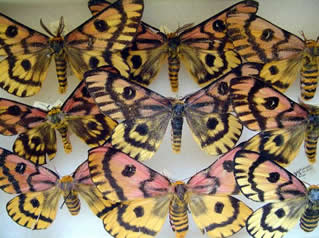
Elegant Sheep-Moth(Hemilenca eglanterina) in the UBC Spencer
Entomological Museum collection.
Photo by Launi Lucus.
The prothorax is usually small, the mesothorax large; the metathorax is a little smaller than the mesothorax in the very old lineages but is much smaller in the Heteroneura. Families of the Noctuoidea have tympanic organs in metathoracic cavities. Legs are developed for walking and perching. Forelegs are reduced in some butterfly families, the hind legs in some hepialids and geometrids; all legs are vestigial in some female Psychidae. The fore tibia has one apical spur or none; the inner surface of this tibia usually bears an epiphysis, a basally articulated, spur-like appendage used for cleaning the antennae and proboscis. The mid tibia usually has a pair of apical spurs and the hind tibia two pairs – an apical pair and a medial pair. The tarsi are 5-segmented and bear a pair of claws, which can be simple, toothed, bifid or reduced.
The wings are the most prominent lepidopteran attribute. They are usually covered on both the veins and membrane with two layers of minute, socketted, flattened setae (scales), which normally contain colour pigments and are finely ridged and usually hollow and microscopically perforated. Iridescent colours are the result of scale structure. Many males have specialized scent scales that help to spread pheromones produced by associated glands. These scales may be scattered among other scales or are concentrated in patches, tufts or wing folds. The venation is relatively simple, with few cross-veins. The most ancestral groups have similarly shaped fore and hind wings and the venation in both wings is similar (homoneurous), resembling that of the Trichoptera. Vein Rs has four branches, Sc and R1 may have two branches, M is almost always three-branched, CuP is present and normally there are three anal veins. The venation of the Heteroneura (“different veins”) shows variable simplification through fusion and loss of veins, especially in the hind wing. The radius in the fore wing usually has five branches but Rs in the hind wing is unbranched and R1 is fused with Sc. The stem of the media is lost in most groups, resulting in the formation of the large discal cell in the centre of both wings and in the most advanced superfamilies CuP is absent in both wings.
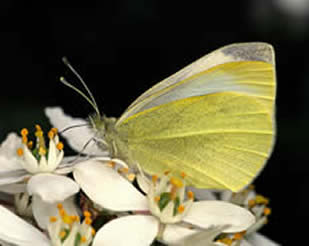
Cabbage White (Pieris rapae) photo by Ian Lane
Wing coupling allows the fore and hind wings to beat together. Moths with homoneurous venation lock the wings with a jugum, a lobe on the inner margin of the fore wing near the base. Most moths in the Heteroneura use a hook and eye mechanism composed of a frenulum at the base of the hind wing and retinaculum on the underside of the fore wing. In males the frenulum is a single, composite bristle; the retinaculum is a membranous lobe. Females have two or more bristles that mesh with a row of bristles in the fore wing. Butterflies and some moths lack a frenulum, but have an expanded humeral area at the base of the hind wing grips the underside of the fore wing. Butterflies usually rest with the wings held together above the body; moths hold the wings outstretched against the substrate, overlapped and flat over the body, roof-like or rolled around the body.
In the abdomen, the top of segment 1 is significantly desclerotized; segments 7 to 11 may be highly modified to form the genitalia. A pair of tympanal organs may be present (e.g., in Pyraloidea, Geometroidea, Drepanoidea) near the base of the abdomen. The cerci are lost. Pheromone glands may occur at various places on the abdomen.
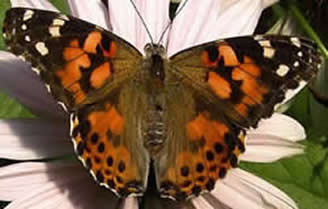
Painted Lady (Vannessa cardui), photo by Diane Williamson
The approximately 200 species of the Micropterigidae, of all living Lepidoptera, are the most similar to the original Jurassic forms. Along with two small families from the Southern Hemisphere, these moths still use mandibles for eating pollen and have not evolved a proboscis for sucking fluids. Many micropterigid larvae feed on plant detritus and fungi, likely the original diet of the ancestors of Trichoptera and Lepidoptera. The huge group Glossata, the “tongued” Lepidoptera, which arose in the early Cretaceous, comprise the rest of the order. Adult mandibles in these species have been lost or reduced and a proboscis used to feed on fluids has evolved from the maxillae; the structure of this feeding tube is unique in the insects. The Glossata also show another major innovation, the spinnerets under the larval mouth that dispense silk. And all but the most primitive glossatan moths have hollow wing scales. Most of the oldest families of Glossata have larvae that feed in leaf mines or are otherwise concealed.
The vast majority of Glossata are included in the Heteroneura where the hind wing veins are reduced and have a different pattern than those of the fore wing. Another critical innovation in this group is the frenulum that links the hind wing to the fore wing. Within the Heteroneura, over 100 families and almost 99% of lepidopteran species belong to the Ditrysia, a lineage whose females have separate genitalic openings for receiving sperm and laying eggs and where these two ducts are linked internally. The larvae of some early lineages (e.g., Gracillariidae) retain the leaf-mining and plant-boring habits or hide in cases or webs, but most feed exposed on plants.
The Macrolepidoptera, a ditrysian group containing the butterflies, skippers and 26 moth families (including most of the more familiar ones) arose around the Cretaceous-Tertiary boundary. Macrolepidopteran species comprise about 60% of the order although most of the thousands of undescribed species will certainly come from earlier lineages, the so-called microlepidoptera. The Macrolepidoptera is distinguished by traits such as the complete loss of wing vein CuP and the crescentic arrangement of the crochets on the inner edge of the end of the larval proleg.
Click here to view a list of the Lepidoptera familes of BC
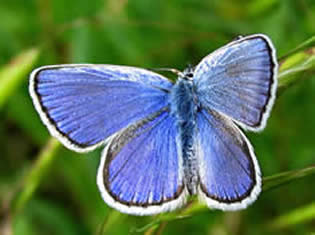
Melissa Blue, male, (Lycaeides melissa), photo by Werner Eigelsreiter
In diurnal species males are initially attracted to females by visual stimuli; in nocturnal forms males respond to sex pheromones from receptive females. Mating may be encouraged by the emission of male pheromones from special glands on the abdomen, legs and wings. Eggs are usually laid on or near the foodplant, singly or in batches. Some insert eggs into plant tissue with cutting ovipositors (e.g., Incurvarioidea, Eriocraniidae) or into grass leaf sheaths (some Noctuidae).
Food plants and more
Lepidoptera species utilize all parts of plants -- roots, trunk, bark, branches, twigs, leaves, buds, flowers, fruits, seeds, galls and fallen material. Larvae feeding in concealed situations -- wood borers, leaf and bark miners, casebearers, leaf tiers and leaf rollers -- usually belong to more primitive families; exposed feeders, especially those that feed by day, are from more recent lineages. The mainly phytophagous (plant eating) habit of the Lepidoptera means that the order does not show the tremendous trophic diversity of the Coleoptera, Hymenoptera and Diptera, although there is some diversity in food other than that of fresh plant matter. Some caterpillars are carnivorous and eat egg masses of other Lepidoptera (some Pyralidae) or spiders (some Oecophoridae); others kill ant larvae (some Lycaenidae) or scale insects (some Batrachedridae, Oecophoridae, Noctuidae). Still others (Epipyropidae) are ectoparasites on planthoppers and leafhoppers and some groups (e.g., Tineidae) feed on material of animal origin such as wool and keratin. The family Pyralidae is especially diverse in its diet. In addition to plants, fresh and decaying plant material of all sorts, foods range from the wax combs of bees to caterpillar spines and processed grains, from scale insects to sloth and bat dung. In the Crambidae, several hundred species have aquatic larvae that feed on waterplants. Adults feed mainly on nectar and other liquid food such as fermenting tree sap, insect honeydew and food-rich fluids in mud and dung. Moths in the Southeast Asian noctuid genus Calyptra have tearing hooks on the proboscis; they suck juice from thick-skinned fruit and blood from mammals. In some lepidopteran groups, adults do not feed.
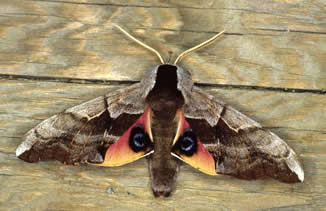
One-eyed Sphinx (Smitherinthus ceerisyi). Photo by Ian Lane.
Enemies
The natural enemies of Lepidoptera are many and varied. Eggs are parasitized by wasps in the Chalicdoidea and Platygastroidea; larvae are killed by mites, spiders, wasps (especially Vespidae and Sphecidae) and vertebrates, mainly birds. Larvae and pupae are heavily parasitized by nematodes, hymenopterous parasitoids in the Chalcidoidea, Braconidae and Ichneumonidae and by flies of the Tachinidae. Bacterial and viral diseases kill huge numbers. Humans feed on a few species; for example, some large cossid larvae are eaten by Australian aborigines and larvae of the saturniid genus Coloradia are used as food by American natives in the western United States. Adults are preyed on by predaceous plants, insects and spiders, birds, bats and many other organisms.
To defend against many of these attacks, members of the order are masters of concealment and deception. Some larvae live in silken cases or webs, others roll or tie leaves and hide in them. Many adults and immatures are amazingly camouflaged as bark, lichen, leaves and twigs. Some even mimic dangerous vertebrates, such as snakes, using eyespots and other startling markings. Many species feign death when attacked; others emit noxious chemicals. Sesiids, especially, can be convincing mimics of stinging wasps. The characteristic scales of adults are dense, dust-like and slippery; they detach easily from the body and wings, sometimes allowing an attacked insect to escape a predator or a sticky spider web. Dense hairs and spines on caterpillars act as barriers to some parasites and, especially those projections that irritate, deter some vertebrate predators. Many larvae and adults sequester distasteful or poisonous chemicals, discouraging vertebrate predation. Hundreds of diurnal species, distasteful or not, gain some protection from predators by mimicking poisonous species or by flaunting bright, warning colours. Most adult moths avoid bird predators by flying at night, but bats pose a serious problem for them. Many groups have tympanal organs that allow moths to hear bat sonar pulses and take evasive actions; some tiger moths emit counter pulses to confuse attacking bats.
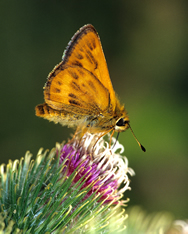
Woodland Skipper, photo by Ian Lane
Economic importance
The Lepidoptera is a major group of plant eating organisms and thus is immensely economically important in agriculture, horticulture and forestry. Agricultural pests of grains and vegetables are numerous and include the armyworms and cutworms of the Noctuidae. This family also contains Heliothis zea (Boddie), the Corn Earworm, a serious pest of a long list of crops. The list of orchard crop pests is headed by the tortricid Cydia pomonella (Linnaeus), the Codling Moth. Forest defoliators are also legion. Among the most damaging are Choristoneura fumiferana (Clemens) (Spruce Budworm) and its western relative C. occidentalis Freeman, the geometrid Lambdina fiscellaria lugubrosa (Hulst) (Western Hemlock Looper), Orgyia pseudotsugata (McDunnough) (Douglas-fir Tussock Moth) and the tent caterpillars of the Lasiocampidae. Several introduced, cosmopolitan moths are serious pests of stored goods in households and warehouses – the clothes moths of the Tineidae and the meal moths of the Pyralidae are the most obvious. Wax moths (Pyralidae) sometimes are economically destructive to honey bee colonies. From the economic perspective, any negative role of Lepidoptera as predators and parasites is minor. They have little medical or veterinary importance although the larval hairs and adult scales may be allergenic and the irritating hairs and spines of some larvae cause pain and skin rashes.
Unlike flies and beetles, Lepidoptera play only a small role in the decomposition of organic material. Some groups are detritovores and fungivores and, to some extent, help in the breakdown of animal and plant remains; for example, the tineid clothes moths recycle wool, feathers and other animal products. Lepidoptera species are overwhelmingly herbivorous but only a few have been used successfully in the biological control of weeds. Examples include Tyria jacobaeae (Linnaeus) to control Tansy Ragwort and the South American pyralid, Cactoblastis cactorum (Berg), brought to Australia to control the introduced Opuntia cactus. Many moths and butterflies frequently visit flowers for nectar and they are probably important pollinators. In some cases the relationship is so specific that some plant species can be pollinated by only certain moths; yucca species and yucca moths of the Prodoxidae are examples.
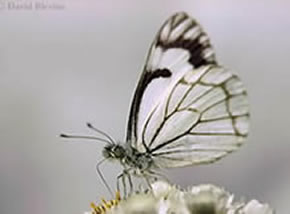
Pine White Butterfly, photo by David Blevins
Scientific importance
The Lepidoptera species have played important roles in biological science. The complex patterns on wings provide an excellent base for study of genetics and embryology. Many of the early triumphs in insect physiology came from experiments on Lepidoptera and the order has played a vital role in studies on mimicry, adaptive coloration and geographical and seasonal variation. Because the habitat requirements and population fluctuations of many rare species are so well known, Lepidoptera, especially butterflies, have had an important place in the development of invertebrate conservation strategies. Art and literature are full of references to the beauty, elegance and symbolism of the Lepidoptera.
Perhaps the single biggest economic and cultural contribution of the order is silk. Mainly a product of Bombyx mori (Linnaeus) (the domesticated silkmoth), this material has been economically important for at least 4000 years and its early importation to Europe opened up connections between eastern and western civilizations.
Structure of the Lepidopera
We use the terminology of Kristensen (1999) when describing the structure of the Lepidoptera.
| Glossary of Terms | |
Apodeme |
In growth of exoskeleton to which muscles attach. |
Aposematic |
Having warning colouration. |
Chaetosema (pl. chaetosemata) |
A cluster of sensory bristles on the head. |
Conjunctiva |
In tympanal organ of Noctuoidea a soft pale membrane separated from tympanum by a sclerotized ridge. |
Endodont |
Internal projection. |
Ephphysis |
A leaf-like or spur-like, basally-articulating process on the inner aspect of the fore tibia of some Lepidoptera, used to clean the antennae. |
Falcate |
Hooked, when there is a deep excavation below apex of wing, so as to have the latter acute and a little curved. |
Flagellomere |
One part of a multiannulated antennal falgellum. |
Flagellum |
The third segment, or terminal part of an antenna, beyond the basal scape and subbasal pedicel segment. |
Patagium (pl. patagia) |
Paired articulated dorsal plates of prothorax. |
Pecten (as in cubital pecten) |
A basal fringe of piliform scales. |
Piliform |
Seta-like in shape or form. |
Praecinatorium |
A ventrally expanded, median flap. |
Scape |
Anterior to tympanal organs the first or basal segment of the antenna. |
Vertex |
Top of head capsule between the eyes. |
Click here to view a list of the Lepidoptera familes of BC
References
Duncan, R.W. 2006. Conifer defoliators of British Columbia. Natural Resources Canada, Canadian Forest Service, Victoria, BC. 359 pp.
Guppy, C.S. and J.H. Shepard. 2001. Butterflies of British Columbia. Royal British Columbia Museum and University of British Columbia Press, Victoria and Vancouver, BC. 414 pp.
Kristensen, N.P. (ed.). 1999. Lepidoptera: moths and butterflies. Vol. 1. Evolution, systematics and biogeography. 491 pp. In M. Fischer (ed.). Volume IV, Arthropoda: Insecta, Part 35. Handbook of Zoology: a natural history of the phyla of the animal kingdom. Walter de Gruyter, Berlin.
Lafontaine, J.D. and J.T. Troubridge. 1998. Moths and butterflies (Lepidoptera). In I.M. Smith and G.G.E. Scudder (eds.). Assessment of species diversity in the Montane Cordillera Ecozone. Ecological Monitoring and Assessment Network. On the internet here.
Lafontaine, J.D. and D.M. Wood. 1997. Butterflies and moths (Lepidoptera) of the Yukon. Pp. 723-785, In H.V. Danks and J.A. Downes (eds.). Insects of the Yukon. Biological Survey of Canada (Terrestrial Arthropods), Ottawa, ON 1034 pp.
Layberry, R.A., P.W. Hall and J.D. Lafontaine. 1998. The butterflies of Canada. University of Toronto Press, Toronto, ON. 280 pp.
Llewellyn Jones, J.R.J. 1951. An annotated check list of the macrolepidoptera of British Columbia. Entomological Society of British Columbia Occasional paper No. 1. 148 pp.
Errata for Butterflies of BC (In Boreus Volume 21, No. 1, 2001)
Note:
This write up is extracted from the forthcoming publication by Scudder and Cannings: the Insect Families of British Columbia.
Illustrations by L. L. Lucas. Copyright © 2005 - All rights reserved
Links
Rare Butterflies of Southeastern Vancouver Island and the Gulf Islands
The International Lepidoptera Survey
Butterflies of Conservation Interest In Alberta, British Columbian and Yukon
Butterfly Conservation Canada (Biodiversity Information Facility)
North America Butterfly Association
Canadian National Collection of Insects, Arachnids and Nematodes
Species Access Canada: Butterflies
Species at Risk: Mormon Metalmark
Field Surveys for the Dione Copper Butterfly
The Sooty Hairstreak in British Columbia & and the Sonora Skipper in British Columbia
Please cite these pages as:
Author, date, page title. In: Klinkenberg, Brian. (Editor) 2021. E-Fauna BC: Electronic Atlas of the Fauna of British Columbia [www.efauna.bc.ca]. Lab for Advanced Spatial Analysis, Department of Geography, University of British Columbia, Vancouver. [Date Accessed]
© Copyright 2021 E-Fauna BC.